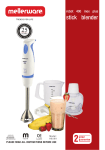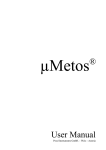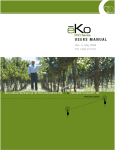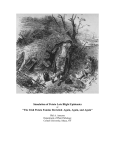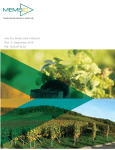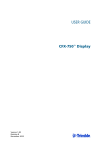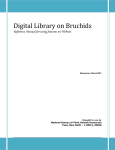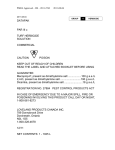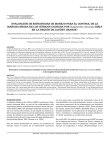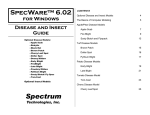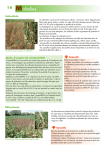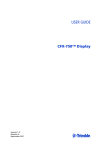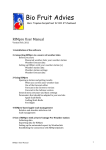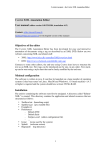Download Evolution of Fungicide Resistance: A Study of Fitness and Selection
Transcript
Apple Scab Fruit Lesions Evolution of Fungicide Resistance: A Study of Fitness and Selection or "Evolution Happens" Phil A. Arneson Department of Plant Pathology Cornell University, Ithaca, NY PREPARATION This exercise is a simulation requiring an IBM-PC or compatible computer running Microsoft Windows. Install RESISTAN by following the installation instructions in the Resistan user's manual, "User_Manual.doc". Prepare a copy of the RESISTAN user's manual by opening the "User_Manual.pdf" document. You may want to make a printed copy of the manual, or you can reduce the manual to an icon to keep it as a handy on-line reference as you run RESISTAN. There is a self-guided tutorial in the manual to help you familiarize yourself with the program before embarking on this exercise. You will also find it useful to get acquainted with a word processor, such as Windows Notepad or WordPad, before you start. These instructions assume that you have a working knowledge of Microsoft Windows. INTRODUCTION Biologists who deal with managing populations of "pest" species know (or ought to know and often forget) that any attempt to kill individuals in a population or limit their reproduction can result in the evolution of a refractory population. Whatever means we 1 use to control a population can impose a selection pressure, as long as there are variants present that have a heritable resistance to whatever control measure is being used. For example, by swatting the slow ones, we can select a population of faster flies (provided that we are able to kill a significant proportion of the whole population). In pest management, by far the most common selection pressure imposed is through the use of pesticides. There are two key reasons for this: the first is that pesticide resistance is often a matter of a single gene change (alteration of a binding site, shift in a metabolic pathway, synthesis of a detoxifying enzyme, etc.) and therefore very common, and the second is that pesticides are often over-used, resulting in a strong selection pressure. The evolution of pesticide resistance, therefore, is a good model for studying fitness and selection in a changing environment. In this exercise, we will use a computer simulation of the selection of fungicide resistance in response to the application of fungicides. The model, RESISTAN, mechanistically simulates the infection, growth, and sporulation of a plant pathogenic fungus and the effects that fungicides have on each of these steps in the fungus life cycle. The structure of the model is generalized, but it can be made to represent a specific fungus and specific fungicides by an appropriate selection of parameters. For this exercise, we will use a set of parameters that realistically represent the control of apple scab (caused by the fungus, Venturia inaequalis) with a multi-site fungicide, captan, and a single-site fungicide, benomyl. Germinating ascospores of Venturia inaequalis The conditions of the simulation. RESISTAN simulates selection in a clonal population (an asexually reproducing, haploid organism) and therefore ignores genetic recombination. No resistance to captan has yet been observed in V. inaequalis, despite its use for almost 40 years, while resistance to benomyl was reported in some orchards after only 3 years of use. The parameters in this data set correspond to rates of fungicide 2 weathering and rates of infection that would occur on a very susceptible cultivar in an unusually rainy season, and the initial inoculum (5000 ascospores/acre) corresponds to a very high level of infection the previous season. Under these conditions captan does not adequately control apple scab, and the quantity of ascospores to begin each successive season creeps upward slowly. Benomyl, on the other hand, will very effectively suppress the development of the fungus and dramatically reduce the amount of initial inoculum the following season (as long as the V. inaequalis population is still sensitive to benomyl). The initial percent resistance to benomyl, 0.0001% (1 ascospore in a million), corresponds approximately to what is believed to be the mutation rate for benomyl resistance in this fungus. PERUSING THE DATA The standard runs. To save you time, several runs of the simulator have been done for you. The attached data (Appendix A) show the percent resistance, active lesions, percent loss, and profit at the end of each season for several consecutive years. (If you want to see the details of disease development and selection of resistance within each season, feel free to run these simulations yourself.) Note first the development of the disease in the absence of fungicides, and then look at the results with each of the fungicides used alone at the labelled doses. Question 1: Under these conditions, why does each of these fungicides eventually fail to control apple scab? In order to detect a problem of resistance, the grower could simply wait for failure of control, or she/he could routinely monitor fungicide resistance at the end of each season by plating spore samples on benomyl-amended media. Question 2: When would the grower become aware of a resistance problem in each case (with and without monitoring resistance)? Apple Scab Leaf Lesions 3 RUNNING "RESISTAN" 1. Double click on the "Resistan" icon to start the Resistan program. 2. Click on OK at the bottom of the title screen. 3. Click on File, move down to Open..., and click again. Locate the cursor on the file venturia.rss, and double click to load the Venturia parameter set. (If necessary to locate the file, move the "thumb" downward on the scroll bar.) 4. Click on Fungicides, move down to Select, and click again. You can apply two fungicides at a time by selecting the desired fungicide in each of the two select windows. Click on one of the fungicide windows until Benomyl appears, then click OK. 5. Click on Fungicides again, move down to Schedules..., and click to bring up the spray schedule window. Click on the fungicide name until Benomyl appears in the window. Check to see that the spray dates and the dose match those in the table in the handout, and make any corrections necessary. To change a value, locate the cursor on the value to be changed (when properly positioned, the cursor changes from an arrow to a vertical bar), hold down the left button, and move the cursor to the right until the entire value is highlighted, then type in the new value at the keyboard. Move the cursor to the next value and repeat the process. Dates or doses can be changed individually, one at a time, or they can be changed all at once by clicking on the Dates or Doses button. Once the spray schedule is ready, click on OK. Initial inoculum. For the data set in the handout, the level of initial inoculum at the time that we first applied benomyl corresponded to a very high level of infection the previous season. Question 3: Do we risk a higher rate of selection of resistance if we use benomyl as a "rescue" treatment (that is, to bring an epidemic under control after the inoculum has been allowed to rise to a high level) than if we use it only to maintain control of a low level of infection? (Explain!) 1. Click on Fungus, Inoculum..., change 5000 to 500, and click OK. 2. Click on File, Run and then press 〈End〉 to let the season go to completion. While the simulation is running, the cursor changes to an icon of an hourglass. Click on View to help you interpret the graph that appears on the screen. Run another season by clicking on File, Continue. There is no need to save the output for this season's simulation. Repeat the simulation for at least four consecutive seasons. 3. At the end of the final season, click on File, move down to Log to Disk..., and click again. Type in a unique 8-character name followed by a period and the 3character extension "TXT" (e.g., initinoc.txt). Close the log file by clicking on File, Close Log File. 4 Reduced dose of benomyl. The data in the table in the handout are based on the recommended dose of benomyl in each spray. Question 4: What would be the effect of reducing the dose of benomyl to half the standard dose on the rate of selection of resistance and the effectiveness of the disease control? 1. Reinitialize the model as before, using File, Open... to open the venturia.rss file. 2. Select benomyl in the Fungicides, Select... dialogue box, and then click on Fungicides, Schedules... to change the benomyl spray schedule. Click on the Doses button at the right of the "SPRAY SCHEDULE" dialogue box, and set the dose for all applications at 0.25 and click OK. (Do not worry if .25 appears in all the dose boxes; if the date is 0, no spray will be applied.) 3. Click on File, Run again to run the simulation for several consecutive seasons until the disease control appears to fail. 4. As before, log the results to a file under a different name and close the file. Reduced host susceptibility. The standard runs in the handout were done with a highly susceptible cultivar. Question 5: Does a less susceptible cultivar offer any advantages in the selection of resistance and the effectiveness of disease control with benomyl? 1. Reinitialize the model with the Venturia parameters as before, then click on Plant, Susceptibility.... 2. Locate the cursor over the black square at the left of the horizontal line at 100%. Press the mouse button down, and while holding it down, drag the square downward until the Y-coordinate reads "80%", then release the button. In a similar manner relocate the right end of the line to 80%. Double click on the - in the top left corner of the Susceptibility Profile dialogue box to return to the main menu. 3. Select benomyl as the fungicide to be applied, using the default spray schedule. 4. Run the model for as many seasons as necessary to see the loss of disease control again. Reduced fitness of fungicide-resistant biotype. All of the evidence so far suggests that in the absence of the fungicide, Venturia populations resistant to benomyl are as fit ecologically as the wildtype populations. However, with some of the other new fungicides, the resistant biotypes seem to be significantly less fit than the wildtype in the absence of the fungicide. Question 6: What is the effect of a slightly reduced fitness of the resistant biotype compared with the wildtype on the rate of selection of resistance and on the rate of reversion to the sensitive wildtype? To observe this phenomenon better, we first had better do a run with no reduction in fitness to resistance to establish a baseline for comparison and follow the selection of resistance during the course of one season. (In this case the values at the end of the season do not tell the whole story. 5 1. Reinitialize the model again with the Venturia parameter set, then select both captan and benomyl for application. 2. Bring up the captan spray schedule and eliminate the first four sprays by entering a "0" in their spray dates. Eliminate all but the first 2 benomyl sprays in the same manner. 3. To give us a visible level of resistance at the start, click on Fungus, Resistance... and enter 10% on the benomyl line. 4. Save this spray schedule and startup values to facilitate setting up the second run. Click on File, Save As..., and give the file a name that clearly identifies it (e.g., fitness.rss). 5. Run the simulation for one season only and observe the pattern of resistance. 6. Save these data in a log file for later reference with the commands, File, Log to Disk..., giving it a name that clearly identifies it. (Be sure to close the log file.) Now that we have a baseline, let us do the same thing, but with a small fitness cost to the resistant biotype. 1. Reinitialize again with File, Open... and using either the RSS file that you just saved or the Venturia data set. 2. If you saved the RSS file before the previous run, you can skip to step 4. Otherwise, set up the same spray schedule as before with two sprays of benomyl followed by captan. 3. Start again with 10% resistance to benomyl. 4. This time click on Fungicides, Characteristics... and bring up the benomyl parameter set. Enter the value of 0.9 in each of the boxes corresponding to "Spore Survival", "Lesion Development", and "Sporulation". (Note: A value of 1.0 means that the fitness of the resistant biotype is equal to that of the wildtype.) 5. Run the model for 1 season as before, save the output in a log file with an appropriate name, and then close the log file. Fungicide combinations. Combinations of a single-site fungicide with a multi-site fungicide, either as formulated combinations, "tank-mixes", or in alternating sprays, have long been recommended as a means of combating fungicide resistance. Some of these recommendations have stated that resistance could be prevented by this means, arguing that the multi-site fungicide in the spray program would kill any mutants resistant to the single-site fungicide. Run RESISTAN for at least 10 consecutive seasons with a combination of benomyl and captan, using the default spray schedules for both fungicides. This is equivalent to applying a tank mix of benomyl and captan every other week and captan alone in the alternate weeks. 6 For the moment, ignore the cost of this spray program (which is unreasonably high). Question 7: (a) If you were assessing the efficacy of this fungicide combination only on the basis of the numbers of lesions visible, how long would it take you to notice a problem? (b) What would be the percent resistance at the time? (c) How long would it be before you would be able to find enough lesions to detect resistance by resistance monitoring? (d) What would be the percent resistance at that time? (e) What is the effect of combining captan with benomyl in this way on the rate of selection of benomyl resistance? (f) Are combinations of benomyl with a multi-site fungicide such as captan an effective way of combating resistance? Explain. Fungicide resistance management. With a fungicide that has no fitness cost associated with its resistance, true management of resistance is not possible -- it is possible to slow down the rate of selection of the resistant biotype, but the frequency of resistance in the population will inexorably creep upward until it finally reaches 100%. With even a small fitness reduction in the resistant biotype, however, it is possible to manage the frequency of resistance in the population while still maintaining disease control. Question 8: Using what you have learned in this exercise, what kind of a spray program would you put together to maintain effective disease control for at least 10 seasons, using only the four fungicides available in the VENTURIA.RSS dataset? (Start with an initial inoculum of 5000 spores/acre and a resistance of 0.0001%.) Include the details (doses and dates of application) of your spray schedules each year and your year-end summaries of resistance and numbers of lesions. PRINTING LOG FILES All of the files that have been created by the Resistan Log to Disk... function are standard ASCII text files. Therefore, they can be printed with the DOS print filename.txt command or edited with any text editor (e.g., Notepad or WordPad). Since the files are rather large, you may wish to edit them to select only the lines that are of particular interest. In most of the runs, you will want to save only the lines in the "LongTerm Summary" at the end of the file. 7 APPENDIX A 1. UNSPRAYED EPIDEMIC Initial Inoculum: 5000 spores/acre Initial Percent Resistance to the Benomyl: 0.0001 End Year 1 2 % Resistance to Benomyl 0.0 0.0 Active Lesions 363872 14704542 % Loss 24.85 95.45 Profit 622.95 -788.87 2. BENOMYL, STANDARD DOSE Initial Inoculum: 5000 spores/acre Initial Percent Resistance to the Benomyl: 0.0001 SPRAY SCHEDULE Benomyl Date Dose (lb/acre) ----------------------------1 0.5 15 0.5 29 0.5 43 0.5 57 0.5 71 0.5 85 0.5 99 0.5 End Year % Resistance to Benomyl 1 2 3 4 0.4708 95.7228 99.9991 100.0000 Active Lesions 67 62 11091 1931922 8 % Loss 0.01 0.01 1.07 60.11 Profit 1035.85 1035.88 014.65 -166.18 3. CAPTAN, STANDARD DOSE Initial Inoculum: 5000 spores/acre Initial Percent Resistance to the Captan: 0.0 SPRAY SCHEDULE Captan Date Dose (lb/acre) ----------------------------1 6.0 8 6.0 15 6.0 22 6.0 29 6.0 36 6.0 43 6.0 50 6.0 57 6.0 64 6.0 71 6.0 78 6.0 85 6.0 92 6.0 99 6.0 106 6.0 End Year 1 2 3 4 5 6 7 % Resistance to Benomyl Active Lesions % Loss Profit 0.0000 0.0000 0.0000 0.0000 0.0000 0.0000 0.0000 4283 10977 28117 71899 183091 461347 1132380 0.43 1.08 2.71 6.61 15.01 29.97 49.69 823.50 810.39 777.74 699.90 531.74 232.53 -161.73 9









